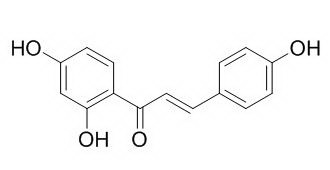Natural Products
Isoliquiritigenin
| Catalog No. | CFN97542 |  |
| CAS No. | 961-29-5 | |
| Molecular Weight: | 256.3 | |
| Molecular Formula | C15H12O4 | |
| DBs | [PubChem]:274952214 [ChEMBL]:310312 [PCIDB]:6925 |
Standard InChI:
InChI=1S/C15H12O4/c16-11-4-1-10(2-5-11)3-8-14(18)13-7-6-12(17)9-15(13)19/h1-9,16-17,19H/b8-3+
Biological Activity
Isoliquiritigenin(ILTG), a flavonoid constituent in the root of Glycyrrhiza glabra, has vasorelaxant effect, anti-platelet, anti-allergic and antiviral activities, also has protective effects in transient middle cerebral artery occlusion-induced focal cerebral ischemia in rats.[1]
Insampaedoksan is a traditional herbal medicine used for antipyretic and antiinflammatory diseases, thus, it has bioactivity effects such as antioxidant, estrogenic and anticancer. [2]
Isoliquiritigenin significantly inhibits the proliferation of prostate and lung cancer cell lines in a dose-dependent and time-dependent manner, suggests that it is a candidate agent for the treatment of prostate、lung cancer and GADD153 may play an important role in isoliquiritigenin-induced cell cycle arrest and cell growth inhibition.[3,4]
Isoliquiritigenin inhibits proliferation and induces apoptosis of U87 human glioma cells in vitro, through cell cycle arrest and the caspase-mediated apoptosis pathway by regulating the expression of specific molecules.[5]
Isoliquiritigenin can inhibit IκB kinase activity and ROS generation to block TNF-α induced expression of cell adhesion molecules on human endothelial cells, these results have important implications for using ILTG or its derivatives towards the development of effective anti-inflammatory molecules.[6]
Isoliquiritigenin has the anti-inflammatory properties, caused by iNOS, COX-2, TNF-α, and IL-6 down-regulation due to NF-κB inhibition via the suppression of IKK, ERK1/2 and p38 phosphorylation in RAW 264.7 cells.[7]
Isoliquiritigenin has the ability to protect cells from AA+iron-induced H2O2 production and mitochondrial dysfunction, which is mediated with GSK3β phosphorylation downstream of AMPK.[8]
Product
Official website: Isoliquiritigenin
Japanese website: Isoliquiritigenin
Chinese website: Isoliquiritigenin
Japanese website: Isoliquiritigenin
Chinese website: Isoliquiritigenin
References
[1] Zhan C, Yang J. Pharmacol Res, 2006, 53(3):303-9.
[2] Lee K J, Jung P M, Roh J H, et al. Asian J Chem, 2014,26(8):24-5.
[3] Kanazawa M, Satomi Y, Mizutani Y, et al. Eur Urology, 2003, 43(5):580-6.
[4] Ii T, Satomi Y, Katoh D, et al. Cancer Lett, 2004, 207(1):27-35.
[5] Zhou G S, Song L J, Yang B. Mol Med Rep, 2013, 7(2):531-6(6).
[6] Kumar S, Sharma A, Madan B, et al. Biochem Pharmacol, 2007, 73(10):1602-12.
[7] Kim J Y, Park S J, Yun K J, et al. Eur J Pharmacol, 2008, 584(1):175-84.
[8] Song H C, Kim Y W, Sang G K. Biochem Pharmacol, 2010, 79(9):1352-62.
[9] Zhao X S, Meng H, Feng J D. Lishizhen Med Materia Medica Res, 2011, 22(4):888-9.
Product Use Citation





